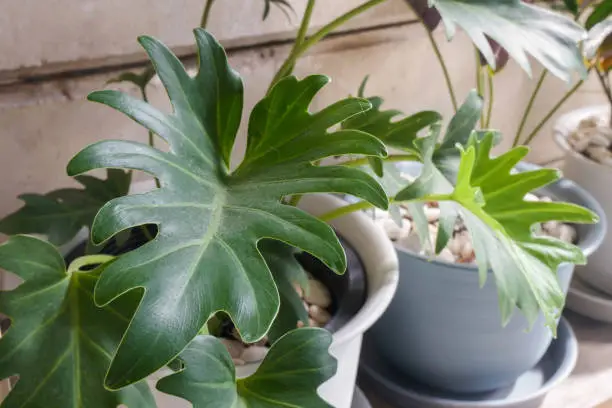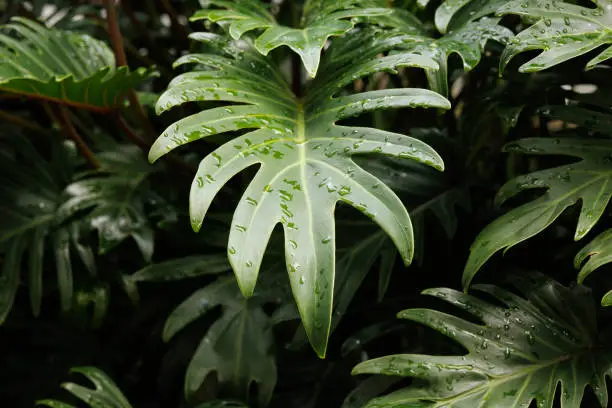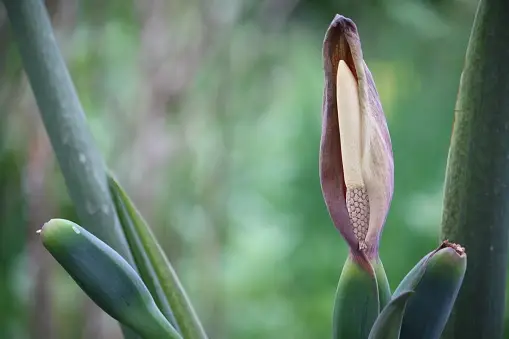Philodendron “Xanadu” is a large-leaved philodendron known for its ease of cultivation and scenic tropical view. Dark grey-green foliage with deep divisions and drooping leaves can reach 45 cm long. The leaves are borne on long. It can only survive and flourish outdoors in South Florida.
Philodendron “Xanadu” is a compact, self-heading plant ideal for miniature terrains. With a slender stem, it reaches a height of 2 to 3 feet. The narrow leaves are shallowly lobed, measuring 6 to 12 inches long with smooth petioles, and divided into 15 to 20 lobes. This versatile plant is well-suited for both sun and shade conditions.

Read: Lemon Lime Philodendron – Propagation, Care, and Benefits
Plant Overview: Philodendron Xanadu
Philodendron “Xanadu” is an indoor plant native to Brazil, levered for its dense and unique appearance. Deeply lobed, glossy green leaves form an attractive mound, an ideal addition to any indoor garden[1]Philodendron Xanadu Plant Overview. Read. Known for its low-maintenance qualities.
The beauty of this Philodendron species lies in its stunning leaves, which portray an intricate pattern. The large, glossy leaves range from vibrant deep green to a lighter shade, creating a mesmerizing contrast. As the plant matures, it forms a dense canopy, enhancing the interior’s beauty.
Beyond its scenic attraction, this Philodendron species functions by purifying the air[2]Air-Purifying Properties of Philodendron. Read, contributing to a healthy atmosphere. With eye-catching vegetation and numerous benefits, “Philodendron Xanadu” becomes a gorgeous addition to your indoor interior.
| Philodendron xanadu Plant Botanical Overview | Description |
| Native to | Brazil |
| Belongs from (Family) | Araceae |
| Maximum Height | 2 to 4 feet (up to 1 meter)[3]General Botanical Information about Philodendron xanadu. Read |
| USDA Hardiness Zones | 10 through 11 |
| Leaf Description | Large, glossy-green, incised appearance |
| Spread (Horizontal) | 4 to 6 feet |
| Flower Color | Red, all year flowering period |
| Plant Type | Shrub, Annually flourishing |
| Flower Hue and Characterization | Hue is Green and Periodically flowers all year |
| Fruit Color | No fruit |
| Bark and stem | usually with one stem and a trunk |
| Spacing requires | 90 – 152 cm |
| Leaf Blade | 30 – 45 cm long |
| Air Humidity at day and night | 60-80% (on Day) and 60-80% (at Night) |
| Temperature Threshold | < 15 °C, Day: 10-30 °C and Night: 12-18 °C |
| Repotting | After 2 Years |
| Soil pH | < 5-8> |
| Soil Type | Peat |
Read: Philodendron erubescens – Characteristics, Toxicity, and Benefits
Philodendron xanadu Characteristics
Its distinctive features include a lack of posterior lobes and poorly developed posterior ribs, which set it apart from other species in its subgenus. It is a terrestrial plant, with leaves extending to 1.6 meters wide and stems reaching 1 meter or more in height.
Leaf and Stem Characteristics
They measure 12 to 18 inches long and exhibit a vibrant green hue while maintaining an evergreen nature. Despite being alternate in arrangement, the plant does not undergo a fall color change. However, the leaves are pinnatisect, subcoriaceous, and directed upward at a 20-30° angle to the midrib. The leaves of this plant are elliptic (oval), showcasing a simple and lobed structure.
The stems are short, dark brown, and with short internodes. However, the stems and twigs of this plant have a green color and are characterized by being very thick.

Inflorescences Characteristics
Inflorescences are singular per axil, with peduncles 8-11 cm long[4]T.B. CROAT, S. MAYO, J. BOOS, 2, A New Species of Brazilian Philodendron subgenus Meconostigma (Araceae), AROIDEANA, Vol. 25, 2002. Read. The spathe is coriaceous, dark purple-brown, and sometimes paler within. The spadix is cream-colored[5]Flower Characteristics of Philodendron xanadu. Read, with staminate and pistillate portions, each having specific dimensions and characteristics.

Reproductive Features
The staminate spadix has sterile and fertile portions, while the pistillate spadix has stigmas and a gynoecium with 7-8 locules.
Read: Silver Sword Philodendron – Propagation, Care, and Benefits
Philodendron xanadu Propagation
Philodendron species can be propagated through cutting and layering during the growing season. Small brown lumps develop and become roots when soil or water comes into contact with leaves. However, the easiest way to prevent rot is to cut a branch below the root nodule (lump) and place it in water containing charcoal (horticultural). Once new leaf growth occurs, it can be potted in well-fertilized soil.
Another way to propagate it in a pot is to pin the vines to the ground at the root nub (lump), where new roots will form[6]Philodendron xanadu Propagational Approaches. Read.
Philodendron xanadu Cultivational Approach
The Philodendron xanadu is an effortlessly cared-for houseplant that can thrive outdoors on a balcony or terrace during summer. Its cultivation requires attention to light conditions, soil moisture, temperature range, and fertilization. Here’s a comprehensive set of instructions on cultivating this plant.
Lighting Conditions
The Philodendron xanadu flourishes in various light conditions, except for direct sunlight. The best place to place the plant is in a partially shaded area or in a location that receives sunlight only during certain hours.
Soil and Watering
This plant prefers a porous soil type, specifically peat, and it is crucial to maintain consistent moisture. However, the soil should be kept quite moist, but excess water must be allowed to drain through the container’s bottom hole to avoid water settling at the bottom. However, watering tips include using a free-draining mixture and ensuring the plant does not retain moisture, promoting a healthy root system.
Temperature and Humidity
Temperatures within 50°F to 86°F are ideal for Philodendron xanadu[7]Philodendron xanadu Plant Care Guide. Read. However, temperature at 59°F (15°C), it can grow comfortably, but this plant should not exceed 86°F (30°C). The plant thrives in a 60-80% humidity range daily and night. This temperature and humidity range mimics its native tropical environment[8] Nainwal P, Review on Philodendron Species-Plant Seeking For Validation of Its Therapeutic Approaches, J. Pharm. Sci. & Res. Vol. 11(5), 2019, 2003-2006 . Read.
Fertilization and Maintenance
Fertilizing the Philodendron xanadu once a month is recommended to stimulate its growth. Use a minimal amount of fertilizer to avoid overfeeding. The low-maintenance plant can be pruned to control its size and shape. Regular care ensures a healthy and vibrant appearance.
Repotting Schedule
Philodendron xanadu typically requires repotting after two years. Meanwhile, during this process, you can inspect the root system, refresh the soil, and provide nutrients to ensure the plant continues to grow properly.

Usage of Shade Net Cultivation
Philodendron ‘Xanadu,’ a perennial evergreen tropical shrub, thrives in partial shade for its glossy green foliage. Cut foliage is utilized in floral arrangements. However, colored shade nets control crop growth and quality by filtering solar radiation[9]N Naveena, Thamaraiselvi SP, et al., Studies on growth and quality of Philodendron xanadu plants under different colored shade nets, IJCS 2019; 7(1): 319-322. Read.
Conclusion
With its low-maintenance nature and adaptability to various conditions, the Philodendron xanadu is an excellent choice for indoor and outdoor cultivation. This article has demonstrated Philodendron Xanadu, a Brazilian houseplant’s care guide, propagational approaches, and characteristics.
References
| ↑1 | Philodendron Xanadu Plant Overview. Read |
|---|---|
| ↑2 | Air-Purifying Properties of Philodendron. Read |
| ↑3 | General Botanical Information about Philodendron xanadu. Read |
| ↑4 | T.B. CROAT, S. MAYO, J. BOOS, 2, A New Species of Brazilian Philodendron subgenus Meconostigma (Araceae), AROIDEANA, Vol. 25, 2002. Read |
| ↑5 | Flower Characteristics of Philodendron xanadu. Read |
| ↑6 | Philodendron xanadu Propagational Approaches. Read |
| ↑7 | Philodendron xanadu Plant Care Guide. Read |
| ↑8 | Nainwal P, Review on Philodendron Species-Plant Seeking For Validation of Its Therapeutic Approaches, J. Pharm. Sci. & Res. Vol. 11(5), 2019, 2003-2006 . Read |
| ↑9 | N Naveena, Thamaraiselvi SP, et al., Studies on growth and quality of Philodendron xanadu plants under different colored shade nets, IJCS 2019; 7(1): 319-322. Read |



